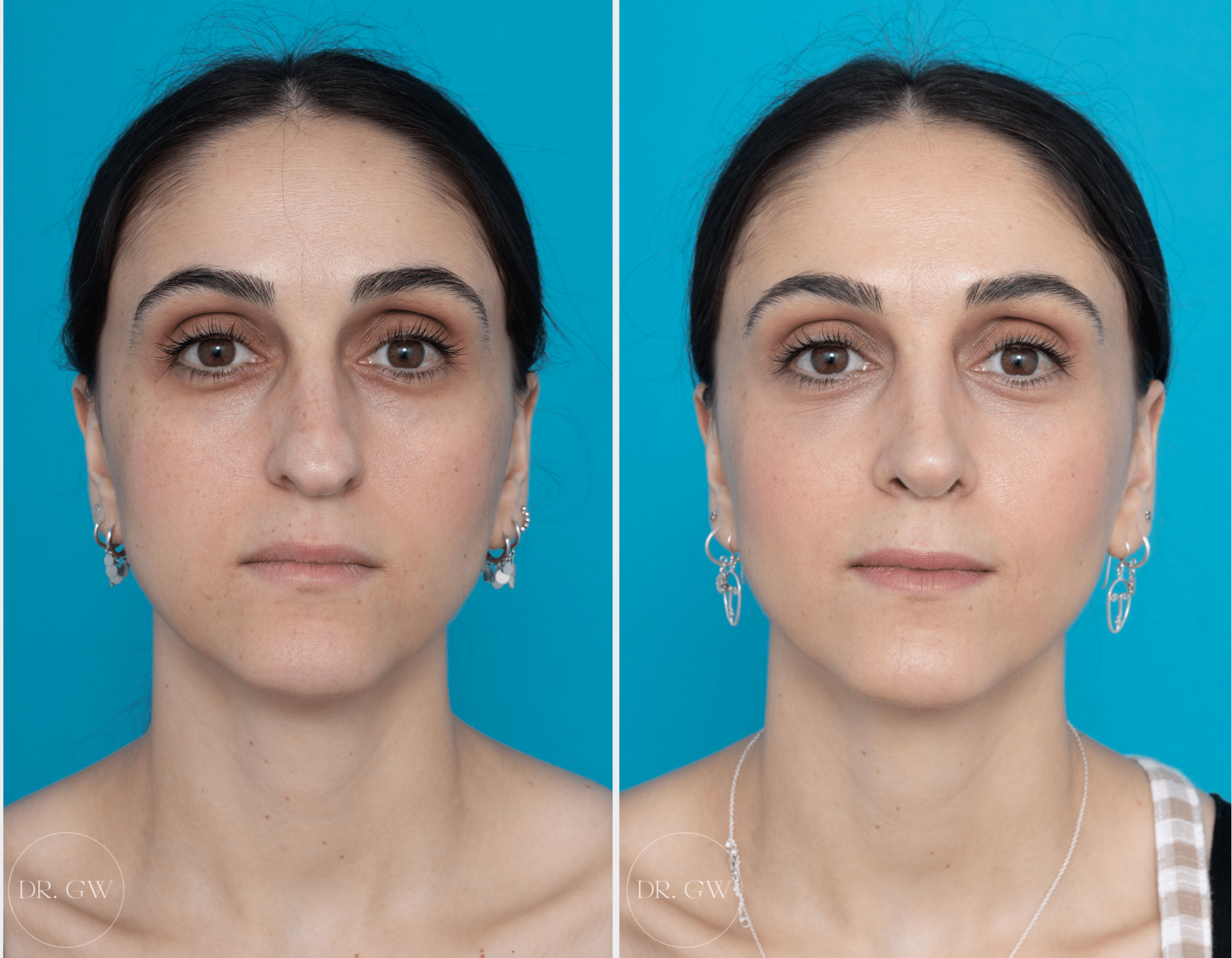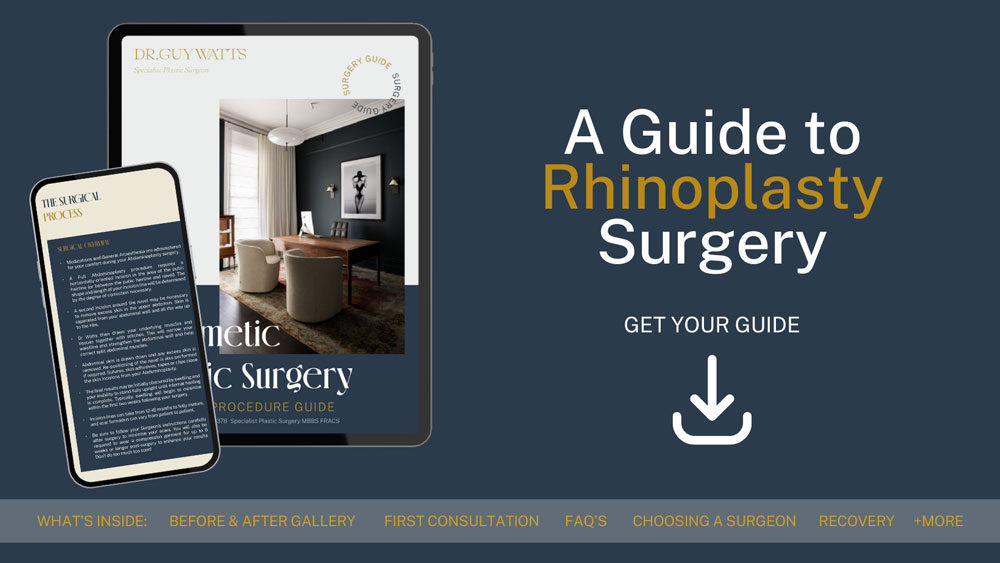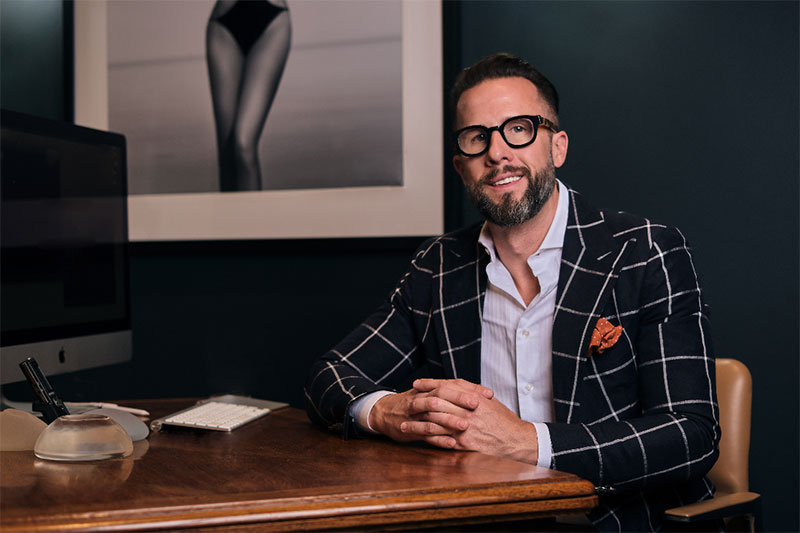
13 Jul Recovery after Nose Surgery
Dos and Don’ts after Rhinoplasty
Now that your rhinoplasty surgery is complete, the focus shifts to your recovery. This stage is important for making sure you heal properly and achieve optimal results. Whether you’re experiencing the initial post-surgery phase or moving into longer-term healing, understanding what to do and what to avoid can make a significant difference.
In this blog, Perth Specialist Plastic Surgeon Dr. Guy Watts will walk you through the things you need to know for your recovery after nose surgery. Dr. Watts will cover immediate post-surgery care, intermediate steps, and long-term tips.
Take our quiz, and find out if you are ready for surgery
The First 24 Hours after Rhinoplasty
Immediately after your rhinoplasty surgery, you’ll find yourself waking up with a splint on your nose and possibly some packing inside. This is an expected part of the experience and serves to control swelling while maintaining the new shape of your nose. The first 24 hours post-surgery are critical, and taking a relaxed approach can set the stage for a restful recovery.
Dos
- Rest: Rest is your top priority during the first day after surgery. Your body needs energy to heal, and rest helps facilitate this process. Keep your head elevated on a couple of pillows while lying down. This position helps reduce swelling by preventing blood from pooling around your nose.
- Follow Instructions: Dr. Watts will provide detailed postoperative instructions. These are specifically tailored to your case and are essential for a successful recovery. Follow these guidelines meticulously, including any prescribed medications and care routines.
- Hydrate: Staying hydrated is crucial for your overall recovery. Drink plenty of water to help your body flush out any anaesthesia and medication used during surgery. Proper hydration aids in reducing swelling and supports your body’s healing processes.
- Cold Compress: Apply cold compresses gently around your eyes and forehead. This can significantly reduce swelling and bruising, common side effects after rhinoplasty. Make sure to avoid direct pressure on your nose, using the compresses intermittently throughout the day as advised by Dr. Watts.
- Eat Soft Foods: Opt for a diet of soft foods. This reduces the need for strenuous jaw movements, which can put unnecessary strain on your nose. Soups, blended drinks, mashed potatoes, and yogurt are all good options.
Don’ts
- Blow Your Nose: Avoid blowing your nose for at least two weeks following your surgery. Blowing your nose can apply pressure to the healing tissues, potentially causing bleeding and disrupting the delicate structures within.
- Touch or Rub Your Nose: You should expect to feel some itchiness or discomfort, but resist the urge to touch, rub, or bump your nose. Any physical manipulation can interfere with the healing process and alter the surgical results.
- Wear Glasses: Glasses rest on the bridge of your nose and can put undue pressure on your healing tissues. If you wear glasses, consider switching to contact lenses or using alternative methods to keep the glasses off your nose, such as taping them to your forehead, for the initial weeks of recovery.
- Bend Over: Avoid bending over or lifting heavy objects, as these actions can increase blood flow to your head and worsen swelling. If you need to pick something up, bend at the knees and keep your head level with your heart.
- Smoke: Smoking is particularly detrimental to the healing process. It constricts blood vessels, reducing the amount of oxygen that reaches your healing tissues and increasing the risk of complications. In order to optimise your recovery you should avoid smoking entirely.
Additional Tips for the First 24 Hours
- Make your Environment Comfortable: Before your surgery, set up a recovery area in your home with everything you might need within handy reach, such as water, snacks, your phone, books, or a tablet. This will reduce the need to get up frequently, helping you to rest more effectively.
- Arrange for Assistance: If possible, have someone stay with you for the first 24 hours. They can help with tasks that require movement and make sure you adhere to your recovery plan.
- Monitor Your Symptoms: While some pain, swelling, and bruising are expected, keep an eye on your symptoms. If you experience severe pain, excessive bleeding, or any signs of infection (such as fever, increased redness, or discharge), contact Dr. Watts immediately.
DOWNLOAD DR WATTS’ ULTIMAGE GUIDE TO RHINOPLASTY

The First Week after Your Nose Surgery
As you progress through the first week after your rhinoplasty, you will start to see gradual changes in swelling and bruising. This period is critical for your recovery, and being patient is essential to make sure your nose heals as planned. Here’s a detailed guide to help you navigate the first week, focusing on what you should do and what you should avoid.
Dos
- Clean the area: Keeping your nose and face clean helps prevent infection and promotes healing. Use a mild soap and lukewarm water. Follow Dr. Watts’s specific instructions on how to cleanse the area without disturbing the surgical site. Avoid scrubbing; instead, gently pat your face dry with a soft towel.
- Light Walks: Slow, light walks can increase blood circulation, which aids in healing and helps prevent blood clots. Take short, walks around your home or in your yard. Aim for about 10-15 minutes a few times a day. Make sure you don’t overexert yourself or engage in activities that could elevate your heart rate too much.
- Communicate: Staying in touch with Dr. Watts is vital as it means that any potential complications are addressed promptly. Keep Dr. Watts’ contact information handy. If you experience unusual pain, bleeding, or other concerning symptoms, contact him or his team immediately. It’s better to ask and be reassured than to let a potential issue go unchecked.
- Rest: Rest is vital for recovery, allowing your body to direct energy towards healing. Continue to prioritise sleep and avoid activities that could disrupt your rest. Consider taking short naps during the day to help your body recuperate.
Don’ts
- Strenuous Activities: Activities that elevate your heart rate or require heavy lifting can increase swelling and risk of complications. Avoid exercise, lifting heavy objects, bending over, and any vigorous physical activities. Stick to light activities until Dr. Watts gives you the green light to resume more strenuous exercise.
- Sun Exposure: Your skin is more sensitive after surgery, and exposure to the sun can cause discoloration or prolonged swelling. When you go outside, apply a high-SPF sunscreen to your face, wear a wide-brimmed hat, and try to stay in the shade. Even brief exposure to UV rays can affect your healing skin.
- Alcohol: Alcohol can thin your blood, which may interfere with the healing process and increase the risk of bleeding. Avoid alcohol entirely during the initial recovery phase. Opt for hydrating beverages like water, herbal teas, and cold pressed fruit juices with no added sugar instead.
- Nasal Sprays: Using nasal sprays or decongestants without Dr. Watts’ approval can irritate your nasal passages and interfere with healing. Unless Dr. Watts has specifically prescribed a nasal spray, avoid using any over-the-counter nasal decongestants or sprays. If you feel congested, talk to Dr. Watts about viable options to manage it.
Week Two and Beyond after Rhinoplasty Surgery
By the second week following your rhinoplasty, you will likely notice a significant changes in how you feel. Most of the initial swelling will have subsided, and Dr. Watts will typically remove the splint. As you continue your recovery, it’s important to understand how to gradually return to your daily activities while optimising healing. Here’s a comprehensive guide on what to do and what to avoid in the weeks and months ahead.
Dos
- Gradual Return to Activities and Makeup: As you start feeling more yourself, slowly reintroduce light activities and exercise. Begin with light exercises like walking and listen to your body to avoid overexertion. If you experience discomfort or swelling, reduce your activity level and allow more time for healing. Additionally, once Dr. Watts gives the go-ahead, you can start wearing makeup again. Use clean brushes and hypoallergenic products to avoid irritation. Be sure to use a light touch when applying and removing makeup around your nose.
- Patience and Long-Term Care: Remember that complete healing takes time. Continue following Dr. Watts’ instructions diligently. Even though you might feel significantly better, your nose is still healing internally, and patience is important to achieve optimal results.
- Sun Smart: Protect your nose from the sun by using a high-SPF sunscreen whenever you go outside and wearing a hat with a brim to shield your face from direct sunlight. Consistent sun protection is essential for at least a year after surgery to prevent discoloration and optimise healing.
- Cleaning and Hydration: Keep your nasal passages clean using a saline solution as recommended by Dr. Watts. This practice helps prevent infection and promotes healing by keeping the area moisturised. Stay hydrated by drinking plenty of fluids, which supports your body’s healing processes.
Don’ts
- Avoid Strenuous Activities and Contact Sports: Refrain from strenuous activities, including exercise, heavy lifting, and any activity that raises your heart rate. Avoid contact sports and activities that could potentially injure your nose for at least six weeks. Sports like football, basketball, and martial arts pose a risk of facial injury and should be avoided to protect your healing nose.
- Be Cautious with Extreme Temperatures: Avoid exposure to extreme temperatures, such as saunas, spas, and extremely cold environments. Sudden temperature changes can cause your blood vessels to dilate or constrict, which can result in increased swelling or discomfort.
- No Smoking: Smoking impedes the healing process and increases the risk of complications. Avoid smoking entirely during your recovery period.
- No Alcohol: Alcohol can thin your blood, interfering with healing and increasing the risk of bleeding. Opt for hydrating beverages like water, herbal teas, and natural fruit juices instead.
FAQs about Recovery after Nose Surgery
How long should I expect to take off work or school after rhinoplasty?
- Recovery time can vary, but most people can return to work or school within 1-2 weeks after surgery. However, it is essential to avoid strenuous activities and heavy lifting for at least six weeks.
- It’s important to discuss your specific situation with Dr. Watts, who can provide tailored advice based on your job requirements and recovery progress.
When will I be able to see the final results of my rhinoplasty?
- While you will notice some changes immediately after the splint is removed, the final results of your rhinoplasty may not be fully visible until a year or more after surgery.
- Swelling can persist for several months, especially in the tip of the nose, and subtle changes will continue as your nose heals and adjusts to its new shape.
Can I wear contact lenses immediately after surgery if I can’t wear glasses?
- Yes, you can wear contact lenses immediately after surgery if you typically rely on glasses. Glasses should not rest on your nose for at least a few weeks post-surgery to avoid pressure on the healing tissues.
- If contact lenses are not an option, you can discuss alternatives with Dr. Watts, such as taping the glasses to your forehead.
Is it ok to experience numbness or altered sensations in my nose after surgery?
- Yes, some patients may experience numbness or altered sensations in their nose and surrounding areas after rhinoplasty.
- This is typically due to swelling and the nerves being affected during surgery.
- Sensations usually return gradually as the swelling decreases and the nerves heal, but it can take several months for feeling to return fully.
What should I do if I experience a nosebleed during my recovery?
- If you experience a nosebleed during your recovery, remain calm and sit upright to reduce blood pressure in your nasal area. Apply a cold compress to the back of your neck and avoid tilting your head back. Contact Dr. Watts immediately for further instructions.
- Frequent or heavy nosebleeds should be addressed promptly to prevent complications.
Further Reading about Nose Surgery with Perth Plastic Surgeon Dr. Guy Watts
- Read more about Turkish Rhinoplasty
- Read more about Nose Shapes and the Different Types
- Read more about Top 5 ways to change your nose
- Read more about Nasal Reconstruction
- Read more about Non-surgical Rhinoplasty
Medical References about Nose Surgery
- Nose Surgery – Australian Society of Plastic Surgeon
- Rhinoplasty – NCBI
- Rhinoplasty – Mayo Clinic
- Rhinoplasty Surgery (Nose Job): Purpose, Procedure – WebMD
- Rhinoplasty: Reference – Oxford Academic
About Dr. Guy Watts – MED0001539378
FRACS (Plas) – Specialist Plastic Surgeon In Perth WA
Dr. Guy Watts is a Specialist Plastic Surgeon (AHPRA MED0001539378) with an extensive career that spans across renowned plastic surgery clinics worldwide. His experience has been honed through invaluable experiences at esteemed establishments such as the New York Eye and Ear Infirmary and the renowned Pitanguy Clinic in Brazil.
Having collaborated with the foremost cosmetic plastic surgeons on a global scale, Dr. Watts has chosen to return to Perth after a 17-year journey of intensive training and invaluable professional experience to bring the latest practices and technology in cosmetic plastic surgery to his patients.
Dr. Watts is a Fellow of the Royal Australasian College of Surgeons (FRACS) and a Member of the Australian Society of Plastic Surgeons (ASPS), Australasian Society of Aesthetic Plastic Surgeons (ASAPS) and the International Society of Aesthetic Plastic Surgeons (ISAPS).
Read about the potential Risks and Complications of Surgery
Read the Patient Information and Resources
About CLINISPA
Clinispa is Dr Watts’ bespoke medical clinic performing Cosmetic Aesthetic treatments. At Clinispa, we offer advanced clinical treatments in a luxurious and calming environment, tailored to support your skin’s health and appearance.
Clinispa aesthetic services are performed by Dr Guy Watts’ nursing professionals, who have a passion for and solid understanding of facial aesthetics.
All Clinispa clients are considered individually, with a personalised treatment plan consisting of advanced scientific approaches to cosmetic aesthetics. We incorporate innovative technologies in conjunction with superiorly formulated skin care.
For more information about the full range of Clinispa Aesthetic of Cosmetic Treatments visit the Clinispa website








Sorry, the comment form is closed at this time.